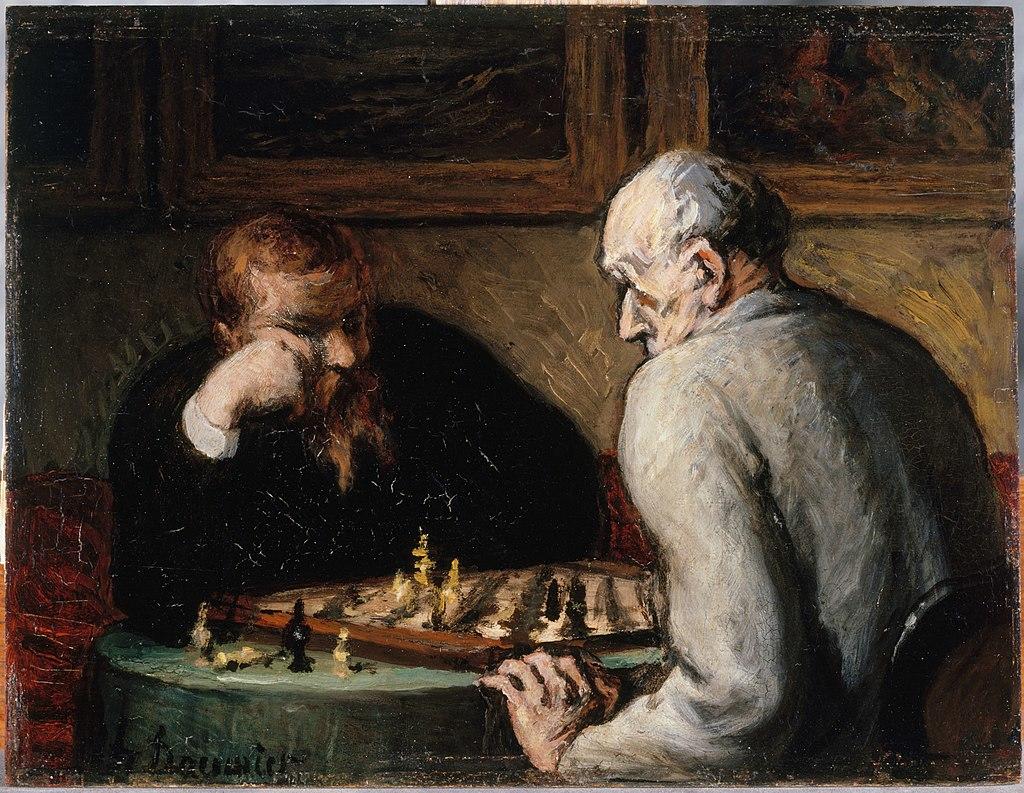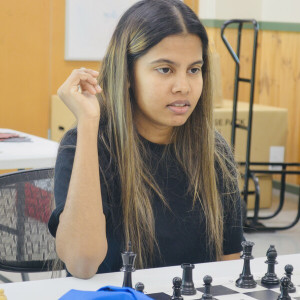A win by an unsound combination, however showy, fills me with artistic horror.
Wilhelm Steinitz
Chess and painting have been around for a long time. People around the world play chess, and paint, too. Humans are as passionate about beautiful tableaux as they are about chess. Could there be two, more complementary disciplines?
The chess master we quote rightly pairs art and chess, as they have quite a lot in common. They both require discipline, focus and good visualisation skills. So, it comes as no surprise that chess features in many pieces of art, including paintings. In this article, we highlight 10 works from that vast catalogue:
| 🎨Painting title | 👨🎨Artist | 📅Year |
|---|---|---|
| The Chess Player | Moritz Retzsch | ~1850s |
| The Chess Game | Sofonisba Anguissola | 1555 |
| Check Mate in Three Moves | Hildur Nilsen Prahl | 1885 |
| The Chess Player | John Macdonald Aiken | 1922 |
| The Chess Players | John Lavery | 1929 |
| Chess with Himself | Grigoriy Myasoyedov | 1907 |
| Chess Players | Julian Rossi Ashton | 1878 |
| Chess Players | Ludovico Carracci | ~1590 |
| The Game of Chess | Lucas van Leyden | ~1508 |
| The Book of Games | Multiple artists likely. | 13th Century |

The Chess Players - Moritz Retzsch
This artist started his career as a painter, etcher and draughtsman at the Dresden Academy of Fine Arts, in 1798. He became a faculty member nearly 20 years later and earned his full professorship five years after that. His artist's bio is rather thin, but his long academic tenure proves his artistic talent.
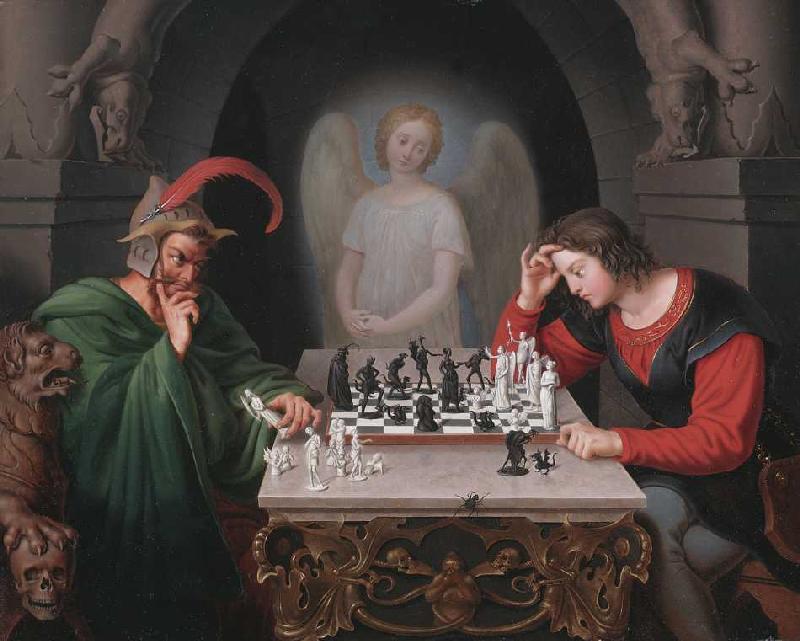
We know that painting theatrical scenes was his bread and butter, but The Chess Players is arguably his most famous work. It shows a game in progress, between someone who is presumably the Devil, and a refined-looking young man. The devil appears smug and confident in his win, as the youth, staring fixedly at the chessboard, seems on the verge of despair.
In the background, an angel looks upon the lad in sorrow. The angel is the most obvious religious element, even the chess pieces reflect the good-versus-evil theme. White's pawns are cherubs while Black's - the devil's pieces, are gryphons. Black's pieces seem lewd and prancing, but White's stand piously; virtuously.
The Game of Chess - Sofonisba Anguissola
Sofonisba Anguissola had a remarkable career, including an early partnership with Michelangelo, in Rome. As her reputation grew, she received commissions to paint noble families all over Italy. She even travelled to Spain, where she became King Phillip II's official court painter.
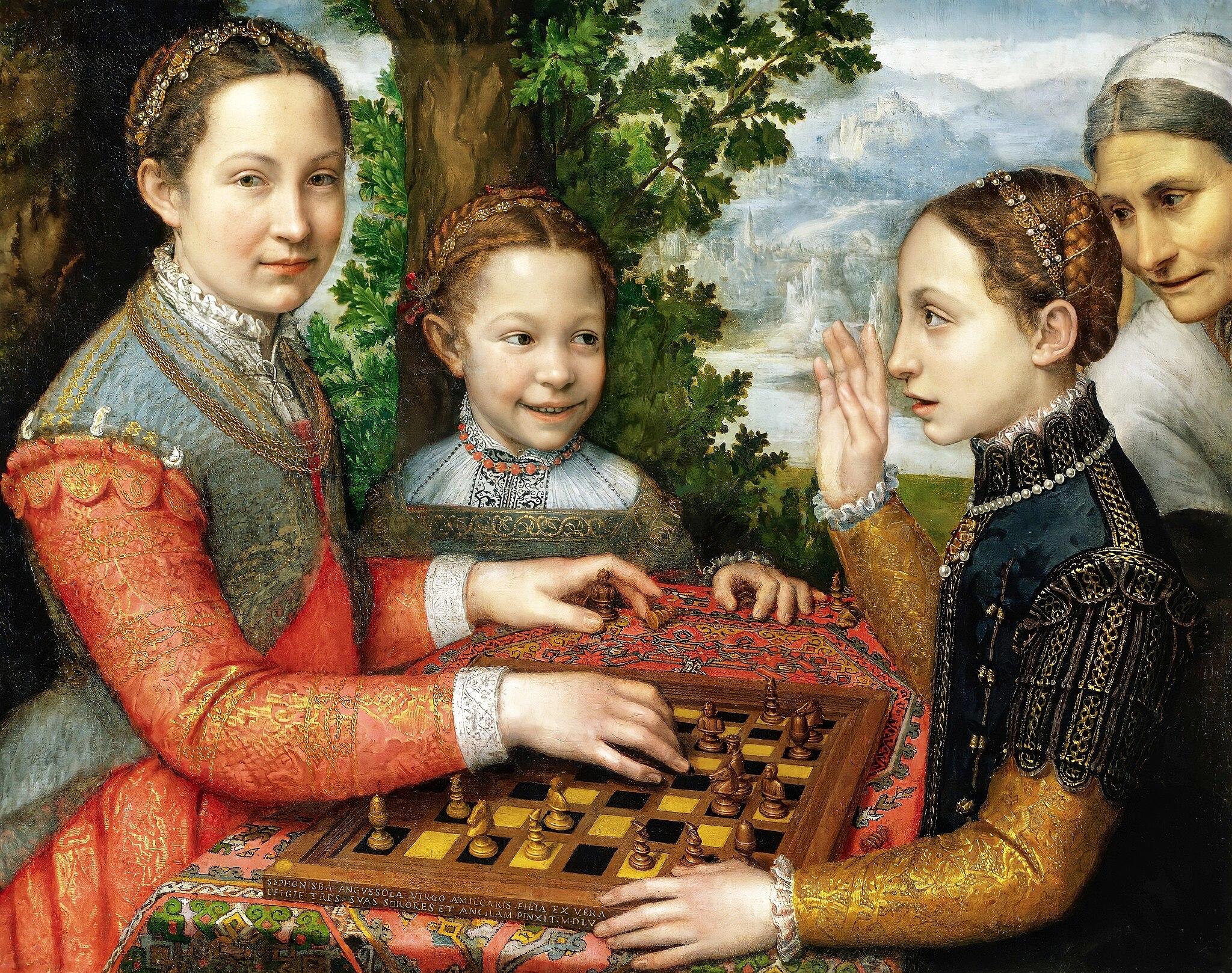
The piece depicts the artist's sisters in a mischievous pretend game of chess. Lucia, the family's third-born daughter, is moving a chess piece while her younger sister seems to warn her of something. The family's fifth daughter looks on, smiling broadly, while their maid watches them play.
Checkmate in Three Moves - Hildur Nilsen Prahl
This tableau shows us two men with moustaches focused on their chess game. The board rests on a corner of a table by a window, which shows the scene in a good light. Looking on, a younger man with a cigarette in his mouth waits for the players' next move.
Try as we might, we found little information about this Danish artist. However, analysing the painting itself, we discover the chess pieces positioned as Hermann von Gottschall discussed in an 1885 publication. Von Gottschall, son of the famous poet Rudolf Gottschall, was a German chess master.
You'll note that many of our featured chess art paintings reflect famous chess problems published in various chess magazines. The problem Ms Prahl depicts appeared in Kleine Problemschule (Small Problem School), a German publication, in 1885.
The Chess Problem - John Mcdonald Aiken
Here we see a chess player, looking somewhat like Albert Einstein on one of his neater days. He focuses intently on the chessboard in front of him. We see no opponent, nor do we see any piles of captured pieces. In fact, the table is just big enough for the chess board, and the pieces form a specific chess problem.
With this tableau, we can have no doubt that the chess art painting reproduces published chess problems. Chess composer Emil Feyerfeil posed this chess question in the 1902 edition of Schachminiatüren (Chess Miniatures). The lack of opponent and captured pieces hints that this chess player is intent on solving the problem, not playing a game.

The Chess Players - John Lavery
We see a well-appointed room, though some might call it shabby. It must be a lovely day, because we see a patch of sunshine splashing across the floor. And, it must be summer, as the two chess players are lightly dressed.
The two girls are daughters of the 8th Baron Howard de Walden. They confront a '2-move' problem on their chess board. They might look so intent because they're trying to find a way out from the inevitable check mate that piece setup promises.
Chess With Himself - Grigoriy Myasoyedov
It's not uncommon for chess masters to muse over their sport. Some, such as this gentleman, game several moves out, devising strategies and plotting alternate moves.
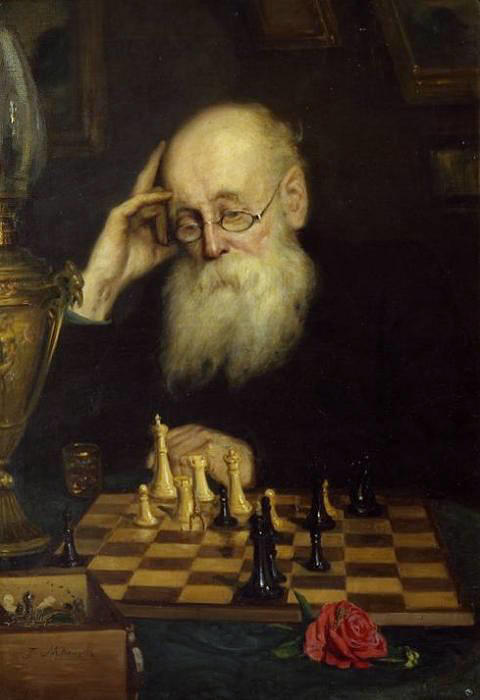
As portraits of chess players go, this one is legendary. Presumably, it shows Russia's first chess master, Alexander Dmitrievich Petrov. He wasn't just a chess master, he was also a chess theorist, and he wrote about chess, too. This chess composer died long before our artist was born, which suggests Grigoriy painted this scene from an early photograph.
Chess Players - Julian Rossi Ashton
This Australian painter, the founder of Sydney's Julian Ashton Art School, made it his mission to capture local scenery. He didn't shy away from painting social scenes, such as this portrait of chess players.
This work treats us to a young, well-dressed lad, sitting opposite a more grizzled player. The youth's hand is on a chess piece, but his eyes appear to look at his opponent. His face bears a slight smirk; perhaps his elder is telling him he'll regret the move?
Or, maybe our dandy just returned from downtown, where he caught the theatre production, Chess, the Musical. He would have impressed his older mentor with that feat! The Fischer/Spassky Match of the Century that 1984 show depicts took place nearly a century after Ashton painted this scene.
Many of the art works we found bear the 'Chess Player' title. We've no explanation for this title being used over and over. Perhaps, because the art world was more fragmented back then, no artist knew that paintings with the same title existed.
Chess Players - Ludovico Carracci
This painting represents a break from Carracci's standard religious themes. He built his reputation on works such as The Lamentation of Christ and Madonna and Child with Saints. This thoroughly secular work shows no hint of religious imagery, not even in the background.
The two gentlemen are neatly groomed and well-dressed, hinting that they are society men. For all the richness - the red and gold, we might guess that they're in a gentlemen's club. No cups or glasses on the table, and no decorations, save for the fancy wallpaper in the background. Why both men have a hand on the board, and why the painting features a little dog, are unclear.
The Game of Chess - Lucas van Leyden
As any chess player would tell you, a quiet environment is necessary to keep one's focus on the game. It appears in this painting that quiet is not the case. We see a crowd of people, seeming to talk with one another. In the foreground, we find a bored-looking chess player on the left side, and a cautious lookiong matron, preparing to make her move, on the right.
Like Carracci, this Dutch painter typically rendered religious scenes. However, he seems more pragmatic in his subject choices, as more of his work depicts everyday scenes. For instance, his Card Game painting, a far brighter work than this one, seems to suggest gambling and cheating.
Perhaps he made the same suggestion in this painting. Note the mysterious hand reaching for the female player's, just as she prepares to move. Was somebody trying to sabotage her chess strategy? As with many of these chess paintings, we can only question the artists' intention.
Together and separately, chess and art have enjoyed longstanding veneration. This painting, in particular, proves that point. Such a renowned and sought-after artist as Lucas van Leyden painting a chess scene must mean that he, too, saw the artistry in this sport.
The Book of Games
Chess artwork reaches far back into history. To wit, King Alfonse X of Castile commissioned The Book of Games - El libro de los juegos, in the late 13th Century. It's full of Illustrations, some in colour, so the reader can master dice games, backgammon and chess.
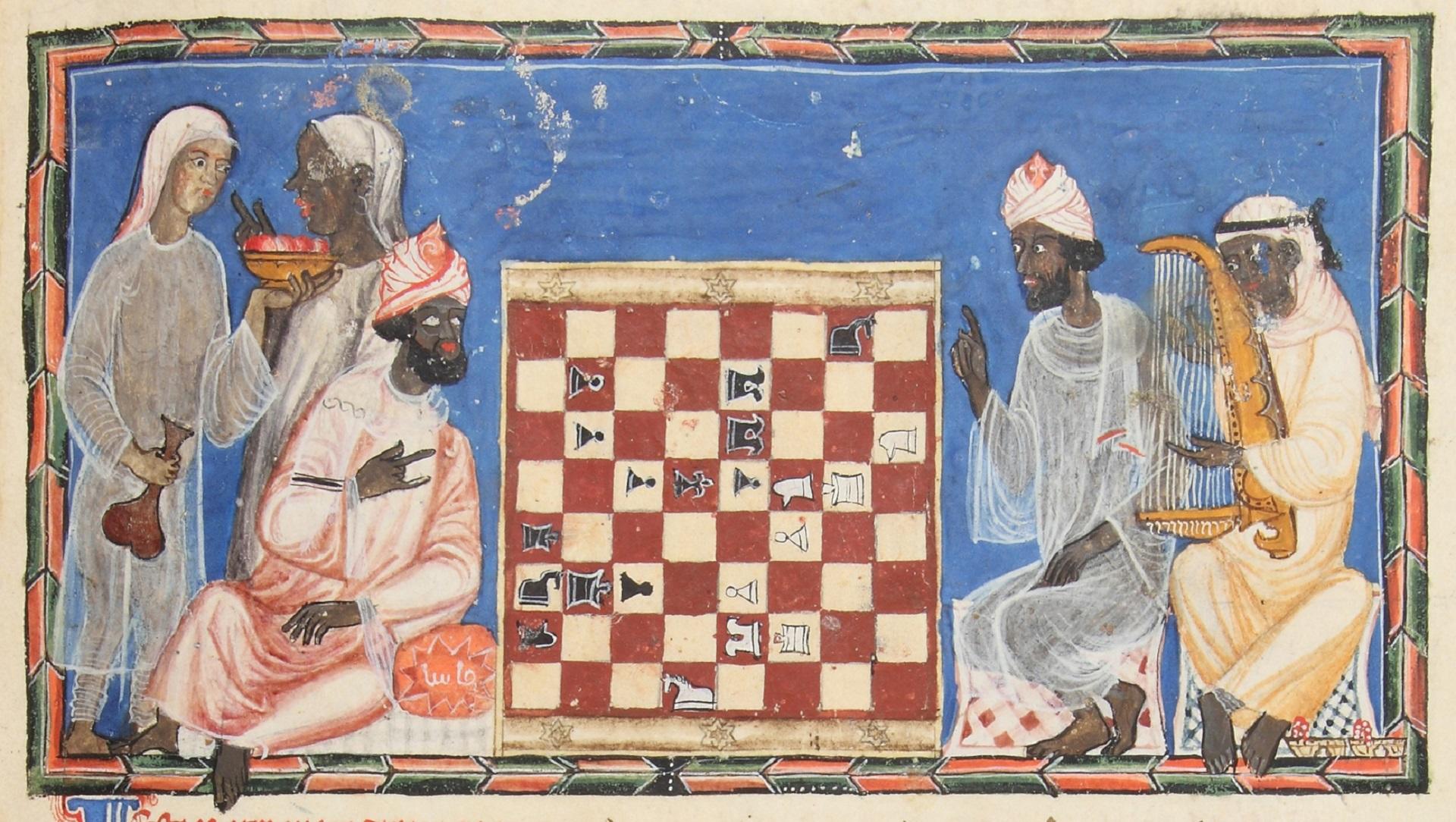
The Libro covers more than 100 chess compositions, as well as chess variants. Furthermore, it contains an outstanding collection of Medieval chess art, a boon for art historians.
The idea of art encompasses far more than just paintings. Art is written works: poetry, prose, and even comics. Television shows and shows on streaming services (The Queen's Gambit, if you please); films, music videos and even video games are also art. Finding chess in art is thus not so unusual.
Still, the question remains: is chess an art? According to Wilhelm Steinitz, the chess composer we quoted, yes. However, the International Olympic Committee recognises chess as a sport. So, we might answer this way: chess is an artistic sport.

